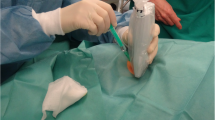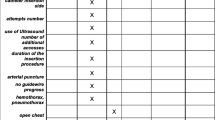Abstract
Central venous devices are frequently used in children to monitor haemodynamic status, to administer fluids, medication, parenteral nutrition and for blood sampling. Life-threatening complications that may occur on insertion if the central venous catheter (CVC) is misplaced, are cardiac tamponade or a hydro-/haemopericardium. There is still controversy over the optimum catheter tip position in paediatric patients, whether to place the CVC tip in the superior vena cava, outside the pericardial boundaries or in the right atrium. However, the exact location of the pericardium cannot be seen on a normal chest x-ray. The carina is a radiographic marker for CVC placement, suggested on the basis of studies with conserved and fresh adult cadavers. In order to confirm this landmark for children, the present study was performed with 31 fresh cadavers of small children (mean age 12.5±3.4 months) that had been selected for autopsy in the Institute of Legal Medicine. Results clearly demonstrate that the carina was 0.5±0.04 cm above the pericardial duplication as it transversed the SVC. In no infant cadaver was the carina inferior to the pericardium. Thus, the results are analogous to those in adults and confirm that the carina is a simple anatomical-radiological landmark, superior to the pericardial reflection, that can be used to identify the placement of CVC even in newborn and small children.


Similar content being viewed by others
Abbreviations
- CVC:
-
Central venous catheter
- SVC:
-
Superior vena cava
- SIDS:
-
Sudden infant death syndrome
- BL:
-
Body length
References
Albrecht K, Nave H, Breitmeier D, Panning B, Tröger HD (2004) Applied anatomy of the superior vena cava - the carina as a landmark to guide central venous catheter placement. Brit J Anaesth 92:75-77
Brown CA, Kent A (1956) Perforation of right ventricle by polyethylene catheter. South Med J 49:466-467
Collier PE, Goodman GB (1995) Cardiac tamponade caused by central venous catheter perforation of the heart: a preventable complication. J Am Coll Surg 181:459-463
Collier PE, Blocker SH, Graff DM, Doyle P (1998) Cardiac tamponade from central venous catheters. Am J Surg 176:212-214
Connolly B, Mawson JB, MacDonald CE, Chait P, Mikailian H (2000) Fluoroscopic landmark for SVC-RA junction for central venous catheter placement in children. Pediatr Radiol 30:692-695
Dollery CM, Sullivan ID, Bauraind O, Bull C, Milla PJ (1994) Thrombosis and embolism in long-term central venous access for parenteral nutrition. Lancet 344:1043–1045
Flatley ME, Schapira RM (1993) Hydromediastinum and bilateral hydropneumothorax as delayed complications of central venous catheterization. Chest 103:1914–1916
Fletcher SJ, Bodenham AR (2000) Safe placement of central venous catheters: where should the tip of the catheter lie? Br J Anaesth 85:188–191
Hayden L, Steward GR, Johnson DC, Fisher MM (1981) Transthoracic right atrial cannulation for total parenteral nutrition-case report. Anaesth Intens Care 9:53–57
Hunt R, Hunter TB (1988) Cardiac tamponade and death from perforation of the right atrium by a central venous catheter. Am J Roentgenol 151:1250
Leibovitz E, Ashkenazi A, Levin S, Nissim F (1988) Fatal pericardial tamponade complicating total parenteral nutrition via a silastic central vein catheter. J Pediatr Gastroenterol Nutr 7:306–307
Marcoux C, Fisher S, Wong D (1990) Central venous access devices in children. Pedriatr Nurs 16:123–133
Quiney NF (1994) Sudden death after central venous cannulation. Can J Anaesth 41:513–515
Raad II, Khalil SM, Costerton JW, Lam C, Bodey GP (1994) The relationship between the thrombotic and infectious complications of central venous catheters. JAMA 271:1014–1016
Rutherford JS, Merry AF, Occleshaw CJ (1994) Depth of central venous catheterization: an audit of practice in a cardiac surgical unit. Anaesth Intens Care 22:267–271
Schneider V, Maxeiner H (1983) Herzbeuteltamponade durch zentralen Venenkatheter. In: Barz J, Bösche J, Frohberg H, Joachim H, Käppner R, Mattern R (eds) Fortschritte der Rechtsmedizin – Festschrift für Georg Schmidt. Springer, Berlin, Heidelberg, New York, pp 116–122
Schuster M, Nave H, Piepenbrock S, Pabst R, Panning B (2000) The carina as a landmark in central venous catheter placement. Br J Anaesth 85:192–194
Suarez-Penaranda JM, Rico-Boquete R, Munoz JI, Rodriguez-Nunez A, Martinez Soto MI, Rodriguez-Calvo M, Concheiro-Carro L (2000) Unexpected sudden death from coronary sinus thrombosis. An unusual complication of central venous catheterization. J Forensic Sci 45:920–922
Timsit JF, Farkas JC, Boyer JM, Martin JB, Misset B, Renaud B, Carlet J (1998) Central vein catheter-related thrombosis in intensive care patients: incidence, risk factors and relationship with catheter-related sepsis. Chest 114:207–213
van Ditzhuyzen O, Ronayette D (1996) Cardiac tamponade after central venous catheterization in a newborn infant. Arch Pediatr 3:463–465
Yoon SZ, Shin JH, Hahn S, Oh AY, Kim HS, Kim SD, Kim CS (2005) Usefulness of the carina as a radiographic landmark for central venous catheter placement in paediatric patients. Br J Anaesth 95:514–517
Acknowledgements
We are very grateful to Prof. Dr. R. Pabst (Head of the Department of Functional and Applied Anatomy, Hannover Medical School) for critical comments and helpful discussions. The authors would like to thank Ms. Sheila Fryk for correcting the English.
Author information
Authors and Affiliations
Corresponding author
Rights and permissions
About this article
Cite this article
Albrecht, K., Breitmeier, D., Panning, B. et al. The carina as a landmark for central venous catheter placement in small children. Eur J Pediatr 165, 264–266 (2006). https://doi.org/10.1007/s00431-005-0044-5
Received:
Accepted:
Published:
Issue Date:
DOI: https://doi.org/10.1007/s00431-005-0044-5




